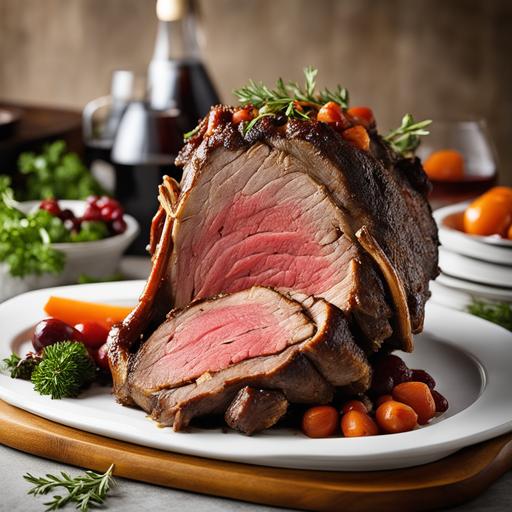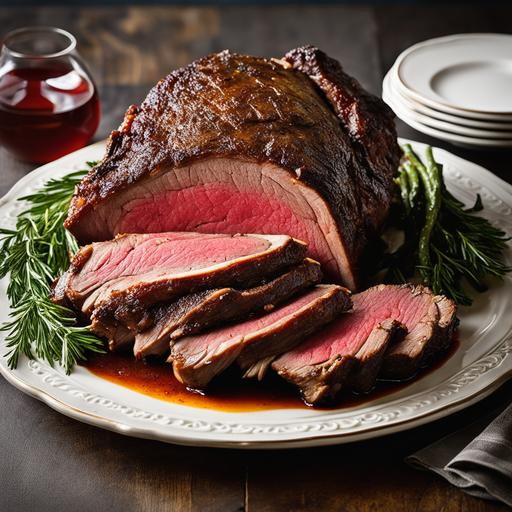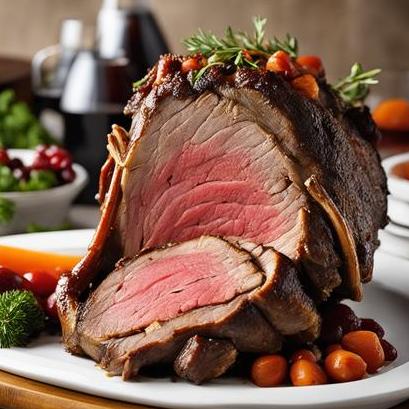
Standing Rib Roast Oven Recipe: The Perfect Showstopper For Your Dinner Party
There’s nothing quite like the aroma of a succulent standing rib roast wafting through your kitchen. The sheer elegance and undeniable appeal of this timeless classic make it the ultimate centerpiece for any special occasion. Whether you’re hosting a festive holiday feast or a sophisticated dinner party, mastering the art of cooking a standing rib roast will make you the culinary star of the evening. In this comprehensive guide, we will delve into the fascinating world of standing rib roasts – exploring their background, intricate culinary details, proper selection, cleaning techniques, preparation tips, variations, ultimate doneness checks, and a tantalizing recipe that will leave your guests longing for more.
The Science Behind a Perfect Standing Rib Roast
Before diving into the details of preparation, it’s crucial to understand the science behind cooking the perfect standing rib roast. The cut, known for its rich marbling, comes from the primal rib section of the beef, nestled between the chuck and the short loin. Its marbled fat content not only imparts intense flavors but also ensures juicy and tender meat. The roasting process involves the Maillard reaction, where the amino acids and sugars in the meat combine at high temperatures to create a beautifully browned crust. However, beware of overcooking, as excessive heat can lead to the dreaded dryness. A precise internal temperature is the secret to a perfectly cooked standing rib roast – between 125-135°F for medium-rare, ensuring a rosy and tender center.
Selecting the Perfect Standing Rib Roast
Choosing a high-quality standing rib roast is essential to achieve outstanding results. Look for a roast with generous marbling, as it is a clear indicator of flavor and tenderness. Opt for USDA Prime or Choice grades, as they guarantee superior quality and marbling. A bone-in roast is highly recommended, not only for its added flavor but also for its ability to conduct heat evenly throughout the meat. Aim for a roast weighing around 4 to 7 pounds, ensuring an ample but manageable size for cooking.
Cleaning and Preparing the Rib Roast

Proper cleaning and preparation are essential to ensure food safety and enhance the final flavor. To start, remove the roast from its packaging and blot any excess moisture using a paper towel. This process helps create an ideal surface for seasoning and searing. Trimming excess fat is a personal choice, but leaving a thin layer intact enhances both flavor and moisture retention during cooking.
Essential Tips for the Perfect Rib Roast

-
Bring the roast to room temperature: Allow the rib roast to rest at room temperature for at least 1-2 hours before cooking. This step ensures even cooking throughout the roast and avoids a cold center.
-
Seasoning for flavor: Generously rub the roast with your favorite seasoning blend, ensuring even coverage. Classic combinations include garlic powder, onion powder, salt, and black pepper, but feel free to experiment with herbs and spices, depending on your preference.
-
Sear for a crispy crust: Before transferring the roast to the oven, it’s essential to sear it on all sides in a hot skillet or cast-iron pan. Searing locks in the juices and adds a delightful, caramelized crust to your rib roast.
-
Roasting temperature: Preheat your oven to 450°F (230°C) for the initial searing step. After searing, reduce the temperature to 350°F (175°C) for the remainder of the cooking time. This gradual heat reduction ensures even cooking and prevents overcooking the outer layers.
-
Using a meat thermometer: To guarantee accurate doneness, invest in a reliable meat thermometer and insert it into the thickest part of the roast. Make sure to avoid touching the bone, as this can lead to inaccurate readings. As mentioned earlier, aim for an internal temperature of 125-135°F (52-57°C) for medium-rare perfection.
-
Resting period: Once your rib roast reaches the desired temperature, remove it from the oven and let it rest, tented with aluminum foil, for at least 15-20 minutes. This resting period allows the juices to redistribute and ensures maximum tenderness and flavor.
Variations and Serving Suggestions

While a classic standing rib roast is undeniably divine, experimenting with variations can add excitement to your culinary repertoire. Here are a few ideas that can elevate your roast to new levels:
Smoked Standing Rib Roast
If you want to infuse your roast with a smoky aroma, consider smoking it. Use flavorful wood chips such as hickory, mesquite, or applewood to create tantalizing smoke that will penetrate the meat. Follow the same preparation and cooking method while adjusting the cooking time to reflect the lower smoking temperature.
Herb-Crusted Standing Rib Roast
For an aromatic twist, create an herb crust to coat your rib roast. Combine fresh herbs like rosemary, thyme, and parsley with minced garlic and olive oil to form a paste. Generously coat the roast before searing to add layers of flavor and visual appeal to the final dish.
Serving Suggestions
Accompanying your standing rib roast with the perfect accompaniments is just as important as the roast itself. Consider serving a rich red wine reduction, a horseradish sauce, or a luscious homemade gravy to enhance the flavors. Traditional sides such as creamy mashed potatoes, roasted root vegetables, Yorkshire puddings, or a fresh green salad complement the roast perfectly and round out your dinner menu.
The Ultimate Standing Rib Roast Oven Recipe
Ingredients:
-
1 standing rib roast, approximately 4 to 7 pounds
-
3 tablespoons olive oil
-
4 garlic cloves, minced
-
2 tablespoons kosher salt
-
2 tablespoons freshly ground black pepper
-
2 tablespoons dried thyme
-
2 tablespoons dried rosemary
Instructions:
-
Preheat your oven to 450°F (230°C).
-
In a small bowl, combine the minced garlic, kosher salt, black pepper, dried thyme, and dried rosemary to create a flavorful rub.
-
Take the standing rib roast out of its packaging and pat it dry with a paper towel. This step is crucial to ensure proper seasoning and searing.
-
Rub the olive oil all over the roast to create a light coating.
-
Apply the herb and seasoning rub evenly over the entire surface of the roast, pressing it gently to adhere.
-
Heat a skillet or cast-iron pan over high heat. Once hot, sear the roast on all sides until a rich golden-brown crust forms.
-
Transfer the seared roast to a roasting pan, placing it bone-side down for even heat distribution.
-
Insert a meat thermometer into the thickest part of the roast, avoiding contact with the bone.
-
Place the roasting pan in the preheated oven and roast at 450°F (230°C) for 15 minutes.
-
After 15 minutes, reduce the oven temperature to 350°F (175°C) and continue roasting until the desired internal temperature is reached. Refer to the internal temperature guide mentioned earlier for the perfect level of doneness.
-
Once the roast reaches the ideal temperature, remove it from the oven and tent it with aluminum foil. Allow it to rest for 15-20 minutes before carving.
-
Carve the roast into thick, succulent slices, aiming for cross-sectional cuts that showcase the beautiful medium-rare center.
-
Serve your perfectly cooked standing rib roast with your choice of sides and sauces, and watch your guests marvel at your culinary prowess!
In conclusion, mastering the art of cooking a standing rib roast is a rewarding journey that elevates your culinary skills to new heights. Understanding the food science, selecting the right cut, and following proper preparation techniques ensure a showstopping result. With the provided comprehensive guide, along with expert tips, flavorful variations, and a mouthwatering recipe, you are now equipped to embark on a culinary adventure that will leave your guests in awe. Unleash your inner chef, embrace the magic of a standing rib roast, and prepare for a gastronomic extravaganza that will be fondly remembered for years to come. Bon appétit!
Sources
FAQS On Standing Rib Roast Oven Recipe
What Is A Standing Rib Roast?
A standing rib roast is a bone-in cut of beef roasted in the oven. Also known as prime rib, it is cut from the rib section of the cow, typically containing between 2 to 7 ribs. It is highly regarded for its tenderness, marbling, and rich flavor.
How Do I Select A Good Standing Rib Roast?
When choosing a standing rib roast, look for a cut that has a good amount of marbling throughout the meat, as this will ensure a juicy and flavorful roast. Additionally, check for bright red meat with a fine texture and avoid any roast with excessive fat or blemishes. Ideally, go for a roast that has been dry-aged for at least 21 days for enhanced tenderness and flavor.
What Is The Ideal Cooking Temperature And Time For A Standing Rib Roast?
Preheat your oven to 450°F (232°C) and then reduce the temperature to 325°F (163°C) once you place the roast inside. The cooking time will depend on the weight of the roast and the desired level of doneness. As a general guideline, calculate about 15-20 minutes of cooking time per pound of meat for rare, 20-25 minutes per pound for medium-rare, and 25-30 minutes per pound for medium. Use a meat thermometer to ensure the internal temperature reaches 120-125°F (49-52°C) for rare, 130-135°F (54-57°C) for medium-rare, or 140-145°F (60-63°C) for medium.
Should I Season The Standing Rib Roast Before Cooking?
Yes, it is highly recommended to season the standing rib roast before cooking to enhance its flavor. Generously rub the entire roast with a mixture of kosher salt, black pepper, and any additional seasonings you prefer, such as garlic powder, dried herbs, or spices. Allow the seasoned roast to sit at room temperature for 1-2 hours before placing it in the oven. This resting period allows the seasoning to penetrate the meat and helps in achieving a more evenly cooked roast.
Do I Need To Let The Standing Rib Roast Rest After Cooking?
Yes, it is crucial to let the standing rib roast rest for at least 15-20 minutes after cooking. This step allows the juices to redistribute within the meat, resulting in a more flavorful and tender roast. Tent the roast loosely with aluminum foil during the resting period to retain its warmth. Avoid slicing into the roast immediately after cooking, as this can cause the juices to escape and result in a drier final product.


